My own interest in this subject comes from the casual research I've done into amphorae for my 2nd LMLK book. Herein I will focus on this PR, & several of the early posts by academicians on the ASOR blog. Though I read many minor typos in these writings (at least half-a-dozen in Tabor's PR), I will forego my normal corrections to focus on my BS-from-BS theme.
Quotations herewith are in chronological order as best I can approximate.
"An April 17, 1981 memo that Kloner wrote right after his team finished their work ... is nowhere to be found. One early Roman period cooking pot was catalogued by the IAA as from this tomb, although excavators remember other items being removed. There is no copy of the excavation license or application in the files. These are unfortunate losses..."--PR p. 2, f/n 3
BS (big surprise & hereafter)! Note that this was done in 1981, not 1881!
"Other than theological objections, the response most often offered to any probable identification of [the other tomb that received much publicity in 2007] with Jesus and his family is that 'the names are common.'"--PR pp. 6-7
BS! Belief in spiritual salvation is theological. Belief in a well-documented historical event is not theological. The only way to argue that the resurrection of Jesus did not occur & still maintain belief in any historical event, is to posit either that God cannot interact with us, which is a theological objection; or that you simply refuse to consider it, which is an arbitrary, hence irrational objection.
"The gospel of John indicates that the initial burial of Jesus near the place of crucifixion was a hasty emergency measure.... What are the chances that Joseph of Arimathea would just happen to have his own new family tomb conveniently located near the Place of the Skull, or Golgotha, where the Romans regularly crucified their victims?"--PR p. 8
BS! What are the chances that Romans would crucify people "conveniently" near any tombs? What are the chances that tombs would be located "conveniently" near a place of capital punishment?
Matthew 27:60 makes it clear that Joseph's tomb is the same one described in John 19:41. An accurate historian takes into account all available evidence unless there's a reason not to. Here Dr. Tabor has failed to give us a reason why we should accept John's more ambiguous version over Matthew's more specific version.
"One would assume a more permanent burial cave would have been provided for Jesus as soon as the Passover was over and burial rites could be completed."--PR p. 9
BS! Only one with an arbitrary bias against the historical record available to us would "assume" such a position.
"If our interpretation is correct this Jonah image would ... represent archeological evidence related to faith in Jesus' resurrection from the dead-—presumably by his contemporary 1st century followers."--PR p. 21
BS! [Take a deep breath; here comes a long sentence...] If Tabor's interpretation is correct, Jesus wasn't resurrected, so His bones were collected by embarrassed family members, who put them in a family-ossuary a couple miles south of Jerusalem, where they would remain available as a testimony against anyone who would proclaim that He had resurrected (which Jewish leaders could use to squelch such proclamations instantly), or that His reference to Jonah would be typologically fulfilled by Him, & thus these members of His family would be the LEAST LIKELY people on the planet to commemorate His false teaching by inscribing an image of Jonah & an inscription praying to God for resurrection on their family's ossuaries.
Tabor's interpretation might be plausible if these tombs were located in Taipei, but not in Talpiot. If his interpretation is correct (based on the belief that Jesus remained dead & decayed), I would expect an image of Jonah coming out the other end of the fish, not from its mouth.
"Accordingly, we take ... the scales or markings on the body to indicate that the fish is 'kosher'..."--PR p. 21
BS! Apparently only half the "fish" was kosher since mostly the top portion & a little of the bottom of the image has markings, & the markings are strangely divided into separate regions bearing distinct patterns. All scaled fish I've seen have similar scales over the length of their body. They don't have scales of completely different shapes overlapping in completely different patterns suddenly changing in contiguous regions. On the other hand, some Hellenistic-Roman funerary pottery bore such markings, as I'll soon illustrate.
"...as if the fish is vomiting Jonah onto the land."--PR p. 21
BS! As if the "fish" is swimming in the sky! If the bottom of the ossuary is the land, where's the water? Jonah 1:15 makes it clear that he & the fish were in the sea, not the sky.
"Along the top border are a series of smaller fish that seem to be swimming along a river."--PR p. 22
BS! Since PR was published, Tabor has published images of these "smaller fish", which are nothing more than decorative ovals. No mouths. No eyes. No fins. No tails. And if they were intended as fish, they would imply that "Jonah" is being vomited to the bottom of the sea, not onto dry land!
"Whether this cross is intended as a Christian symbol or not belongs to the larger question of how the tomb is interpreted as a whole..."--PR p. 22
BS! Why would only one ossuary have Christian symbols if the "whole" tomb belonged to Christians?
"On the right end of the ossuary is the scaled body and tail of a fish, with only the lower portion shown as if it is diving down into water (Fig. 24)."--PR p. 22
BS! And the rational basis for believing one "fish" is diving under the water & another "fish", oriented exactly like the other, is vomiting a man onto dry land is ... wait, let me guess, it's because we always find dry land under water, right? And again we see a compartmented region of scales, but ordinary section of decor if it's a jar.
"Although we initially considered the possibility that the image might be ... perhaps a crudely drawn amphora, we soon realized that we were dealing here with something far different..."--PR p. 23
BS! Wait, let me guess. How about a crudely drawn fish using its half-scaled body to swim in the sky? That would definitely be "far different"! For now I'll stick with the crudely drawn jar.
"We have carefully examined all the extant examples of nephesh and amphora on ossuaries of this period and have not found anything that is even close."--PR p. 23
BS! Maybe Dr. Tabor would find something "even close" by looking at images of real amphorae, & comparing their key features.
To isolate the features I would use to interpret this ossuary art, I made my own drawing based on a composite of the "original Jonah Image - no cgi" & "Detailed Jonah Image - no cgi" photos presented in the Photos & Graphics section of The Jesus Discovery's website:
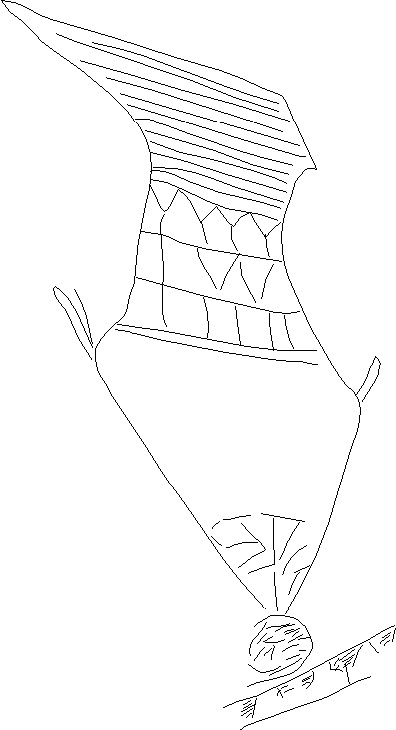
As is obvious, I did not attempt to correct for the skewed camera perspective, & did not attempt to restore the obstructed top-right region, but I did rotate it so it would be shown in its intended orientation, & I did utilize the only 2 non-cgi images made available at this time. I disagree with the representation shown in the Discovery Center's full-size replica interpretation where the jar's top/opening appears slanted. I see no such slant warranted from the distance between the jar & the decorative border (I say this based on my examinations of photographic skew of many published LMLK seal impressions). Two important features of this stand out:
- 5 patterns placed in distinct regions with a 6th region mostly void
- A distinct knob-like component on the bottom
- Nearly symmetrical handles as expected for a jar, but not for dorsal & pelvic fish fins (based on the orientation of the tail)
Here is my isolated drawing of the alleged figure of Jonah, rotated 180 degrees to show its similarity to a schematic human:
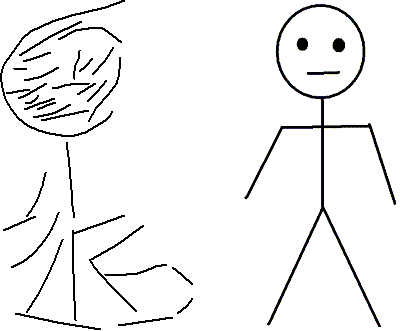
If it were important enough for the family to convey the message of Jonah via this imagery, & since we know the family was literate based on the other inscriptions, why didn't someone simply inscribe the few letters for Jonah's name in Aramaic, Greek, or Hebrew? Of course, there's always the possibility that such an inscription exists in the large obstructed portion of the ossuary's face, so that would definitely falsify my interpretation.
Note that the multiple incisions Tabor interprets as seaweed wrapped around Jonah's head were also incised in the decorative border. It seems odd that an artist would go through the time-consuming labor of making all of these decorative marks along with the alleged "scales" on only one half of the "fish", but not make any more prominent distinction of the key figure, Jonah.
I realize that the following photos depict objects not associated with 1st-century Roman empire; however, Tabor has argued that his interpretation of Jonah & the fish is "unprecedented" (PR pp. 22, 23, 27), meaning that there are not only no contemporary parallels, but no similar images at all. At least the objects I'm using to interpret the ossuary image were in existence.
In other words, if someone were to argue that there's no evidence that a member of this Talpiot family had seen one of these jars, I would easily counter by arguing that there's no evidence they had ever read the book of Jonah since no copies of it were found in the tomb.
Furthermore, since this essay is the product of a few hours of Internet research, on which only a small portion of museum pieces have been published, I would argue that if I had the ability (time + money + permission) to examine excavated jars at every major museum housing Roman-era jars, I'd be able to find contemporary specimens bearing similar features.
This example of a pithos-amphora (from 7th-century BC Thebes at the National Archaeological Museum of Athens; photo courtesy of Ancient Greek Thesaurus) shows how a flat top & rounded base could be the product of artistic perspective:
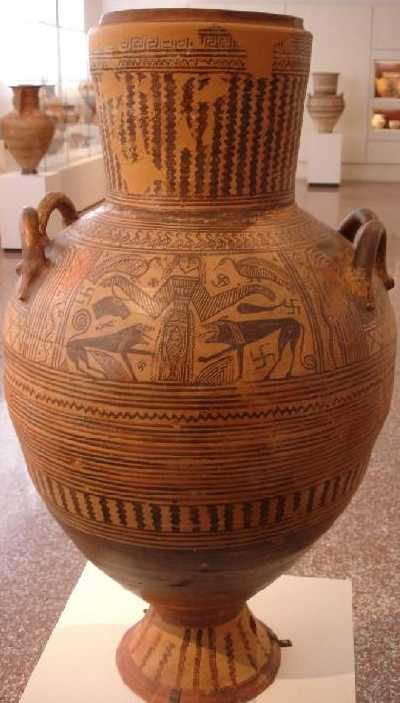
This fragment (from a Roman-era East Mediterranean site at the Mortimer Wheeler House; photo courtesy of Museum of London) shows knob-bottoms were a common feature on ancient jars at this time:
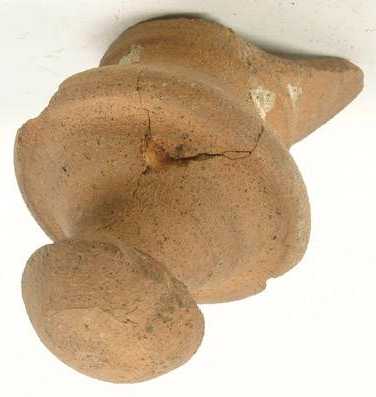
This example of a Hellenistic-era Rhodian amphora (from an unspecified site; photo courtesy of The Institute for the Visualization of History) shows an entire knob-bottomed amphora:
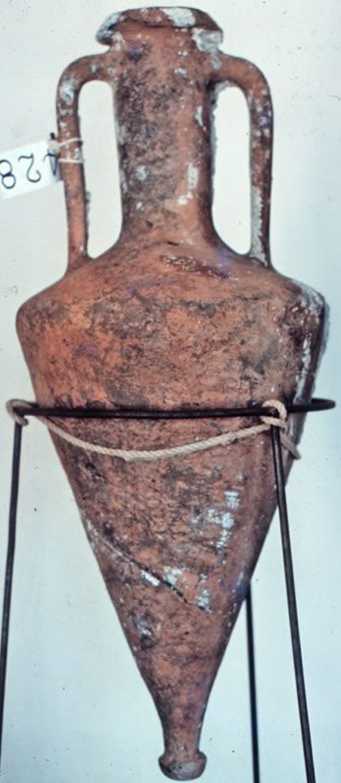
This example of a tripod-amphora (from 9th-century BC Athens at the National Archaeological Museum of Athens; photo courtesy of Ancient Greek Thesaurus) shows a flared neck:
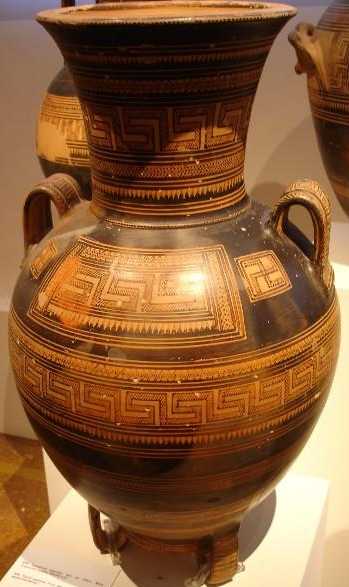
This example of a hydria (from the 3rd-century BC at the Ashmolean Museum of Art and Archaeology, University of Oxford; photo courtesy of Corpus Vasorum Antiquorum) shows an undecorated lower half:
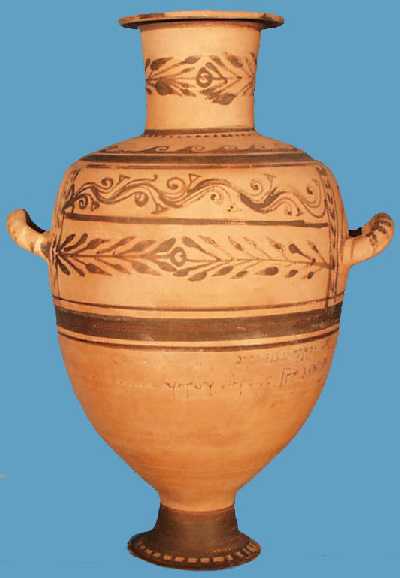
Again, I'm not suggesting that the person who decorated this ossuary used any of these jars in particular, but merely that the features we see on the ossuary image existed on real jars. Oh, & just in case those little ovals were intended to be real fish, please note that along with wine & oil, many of these ancient jars stored garum, which is a salt-fish paste or pickled fish. (I pulled that tidbit from Table 56 of my LMLKv2 draft, which lists 14 other contents stored in ancient jars.)
Now I will address the big surprises in posts by equally brilliant scholars on the ASOR blog in response to Tabor's PR.
"The book is truly much ado about nothing..."--Eric M. Meyers
BS! All excavations in Israel are important, & the finding of Roman-era inscriptions & artwork without any clear parallels by using innovative 21st-century technology is not "nothing".
"Unless one believes Jesus body was taken to heaven, which historians do not entertain..."--Tabor in response to Meyers
BS! I'm a historian, & not only entertain it, but embrace it. Archbishop James Ussher was an excellent historian at his time with the information available to him, & he believed it. I have not yet read a single historian who can dismiss the evidence for Christ's resurrection while providing a rational basis for any other historical event.
"7.The ornamentation on the ossuary in Talpiyot Tomb B that Tabor and Jacobovici wish to consider Jonah and the Whale is a nephesh tower or tomb facade..."--Professor Christopher A. Rollston
BS! It's amazing that he would make such a definitive statement when he didn't even check to see how the object was oriented. He made this mistake by wanting to show support for the suggestion made by Meyers on the same occasion (Feb. 28), who was referring to an image in "The New Jesus Discovery" book. Meyers cautiously said "the image actually seems to resemble a nephesh, or tomb monument," & can be easily forgiven.
"Predictably, therefore, there are ornamental motifs on the ossuaries in Talpiyot Tomb B."--Professor Christopher A. Rollston
BS! Predictably? You mean archeologists don't need to use an old-fashioned crystal ball anymore, they can just call Prof. Rollston to predict whether an ossuary will or will not bear ornamental motifs?
"By the way, the features of this ossuary's ornamentation that Jacobovici and Tabor contend are the 'fins of a fish,' are actually a standard feature of a roof, namely, the eaves (which, of course, are important for directing the water away from a building)."--Professor Christopher A. Rollston
BS! Right now the only thing these "eaves" are directing is embarrassment onto Prof. Rollston's reputation for misinterpreting an image of which he didn't confirm the orientation.
"It is not prudent to assume that the word Mara is definitely feminine."--Professor Christopher A. Rollston
BS! The Jacobovici/Tabor position has every right to read Mara as feminine. Rollston has not given any basis for believing that it can never be feminine, so I would argue that his point is not prudent.
"With little fish swimming around it..."--Tabor in response to Professor Christopher A. Rollston
BS! The ovals Tabor identified as fish are only at the top, which is why he interpreted them as swimming in a river (instead of a sea per the book of Jonah).
"...the fact that the supposed whale appears to be a depiction of a nefesh (tomb marker)."--Professor Jodi Magness
BS! Fact?
"The current claim is based on finds that have no context, as they have not been excavated."--Professor Jodi Magness
BS! I am not aware of any site anywhere that has been completely excavated in scientifically. Normally only very small sections of it are examined, & historians interpret the relatively few findings as best they can. Dr. Magness knows this, but went overboard in her point. Say what you will about the images & inscriptions on the ossuaries under discussion, but at least we know some basic facts about where they were found, & that's better than nothing.
I've made fun of Robert R. Cargill's hasty & embarrassing misinterpretation of the ossuary image elsewhere, so here I'll simply emphasize what a BS it was to see him focus on differences between Dr. Tabor's originally skewed & subjectively edited photos, rather than simply admit he blew it.
"This so-called Jonah 'icon', is nothing more than the image of an ancient Jewish tomb incised on the side of an ossuary. In fact, it is a very nice image of one."
BS! Maybe the upper decorative regions resemble decorative regions of tomb images, but I haven't seen any images of tombs with flaring tops & narrowing/pointed bottoms (& upside-down eaves). Dr. Fine certainly didn't provide any specific references.
"As one of our consultants pointed out—the artist who drew this image was likely reluctant to represent a clear human figure in graphic form in a funerary context."--James D. Tabor
BS! If it was considered taboo, why draw it at all? Would a weird-looking human figure really be kosher?
"Also the “tail” i.e. does not look at all like the mouth of such a vessel, but has a very prominent, asymmetrical left tip."--Tabor in response to Dr. Joan E. Taylor
BS! How could the left "tail" be asymmetrical when the right "tail" is obstructed from view? However, the top of the image on the right side of the ossuary is symmetrical, just like all the jars I've seen.
Let's close with a BS tune from Heritage Singers:
G.M. Grena

No comments:
Post a Comment